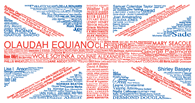About Union Blacks
Art often concerns itself with the notion of identity. To explore a sense of place in the world as an individual or a member of a group is not unusual. To emerge from the inquiry (or to continue it) constantly faced with contradiction is not unusual either. Perhaps this is the beauty.
In Union Blacks Colin Anthony Graham has many aims. By focusing on specifics (images and individuals) he attempts to create a notion of the diversity of a culture.
By taking the image of the Union Jack and subverting/reworking it to contain the names of significant Black groups and personalities, Colin claims a potent image. Looking at the flags allows us to reflect on an aspect of culture which is inherently British, part of our culture (black or white), which is sometimes overlooked as such.
The Union Blacks flag gives a modernity and immediacy to this notion. This is complemented by the second flag (Windrush) which gives a definite sense of history. Whilst going into more detail, the portraits which surround these flags go further to confirm a notion of individuality. Each picture looks to capture the essence of the individual rather than to create a unity between the pictures. There are also text based portraits of Lennox Lewis and CLR James reflecting a dictionary style description of each character.
The subject also stretches across a broad spectrum. Taking in historical figures such as Mary Seacole, as well as young personalities such as Ty, Courttia Newland, Malika Booker, who undoubtedly have a different spin on the notions which the artist is exploring.
The British experience is not a singular one but a multiple one. The cultural mix which now exists in this country is identified and celebrated by many people. Union Blacks looks to mark this by recognising a history, our history, as a living, organic thing.
About the Artist
Colin Anthony Graham is a Graphic Designer by profession. He is also an artist interested in challenging notions of identity and diversity. Using mixed media he attempts to represent real and abstract forms and notions which deal both historically with his place in a generation of people of Afro-Caribbean origin, as well as a member of a wider international society and culture.
His work is influenced by aspects of the community. Through his work, he seeks to highlight the influence of personalities who have shared and contributed to the British experience. In this, he is not celebrating the individual but using them as conduits who characterise our past, present and future history, and make a wider statement which maintains and praises British diversity, while illuminating its rich multi-culture.
